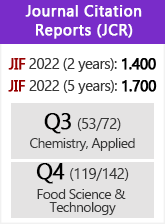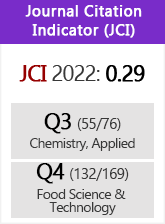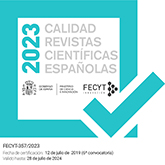The effect of microwave pre-treatment of rapeseed on the degradation kinetics of lipophilic bioactive compounds of the oil during storage
DOI:
https://doi.org/10.3989/gya.0670171Keywords:
Antioxidant capacity, Carotenoids, Degradation kinetics, Microwaving, Rapeseed oil, TocochromanolsAbstract
This study examined the storage stability of tocochromanols and carotenoids in the oils prepared from microwave pre-treated (MV) rapeseeds (2-10 min, 800W) during storage at 20 °C for 12 months. In line with lipophilic antioxidant degradation throughout the storage period, changes in the antioxidant capacity of the oil were monitored. Microwaving significantly affected the concentration of lipophilic antioxidants in the oil. After 10 min of MV pre-treatment the highest content of total tocochromanols (76.64 mg/100g) was achieved, whereas a maximum carotenoid concentration (861.28 μg/100g) was obtained following 6 min seed MV pre-treatment. The degradation kinetics for the tocochromanols and carotenoids followed a zero-order kinetic model. From the kinetic analysis, it was shown that the degradation rate constant (k) of both tocochromanols and carotenoids decreased with longer seed exposure to MV radiation. The kinetics of antioxidant capacity degradation during the storage of oils followed a zero-order reaction. The rate of antioxidant capacity degradation in the control oil was higher (k=9.1 x 10-2 mmol TEAC/l/month) compared with oils prepared from MV pre-treated seeds (k=6.8-8.0 x 10-2 mmol TEAC/l/month).
Downloads
References
Achir N, Pénicaud C, Avallone S, Bohuon P. 2011. Insight into ?-Carotene Thermal Degradation in Oils with Multiresponse Modeling. J. Am. Oil Chem. Soc. 88, 2035– 2045. https://doi.org/10.1007/s11746-011-1864-2
Achir N, Randrianatoandro VA, Bohuon P, Laffargue A, Sylvie Avallone S. 2010. Kinetic study of ?-carotene and lutein degradation in oils during heat treatment. Eur. J. Lipid Sci. Technol. 112, 349–361. https://doi.org/10.1002/ejlt.200900165
Anjum F, Anwar F, Jamil A, Iqbal M. 1999. Microwave roasting effects on the physico-chemical composition and oxidative stability of sunflower seed oil. J. Am. Oil Chem. Soc. 83, 777–784. https://doi.org/10.1007/s11746-006-5014-1
Cai L, Cao A, Aisikaer G, Ying T. 2013. Influence of kernel roasting on bioactive components and oxidative stability of pine nut oil. Eur. J. Lipid Sci. Technol. 115, 556–563. https://doi.org/10.1002/ejlt.201200337
Codex Stan. 2013. Codex Standard for Named Vegetable Oils. FAO/WHO, Rome, (Codex Stan 210-1999).
Choe E, Min DB. 2009. Mechanisms of Antioxidants in the Oxidation of Foods. Compr. Rev. Food Sci. Food Saf. 8, 345–358. https://doi.org/10.1111/j.1541-4337.2009.00085.x
Henry LK, Catignani GL, Schwartz SJ. 1998. Oxidative degradation kinetics of lycopene, lutein, and 9-cis and all-trans ?-carotene J. Am. Oil Chem. Soc. 75, 823–829. https://doi.org/10.1007/s11746-998-0232-3
Krichene D, Salvador MD, Fregapane G. 2015. Stability of virgin olive oil phenolic compounds during long-term storage (18 months) at temperatures of 5-50 °C. J. Agric. Food Chem. 63, 6779–6786. https://doi.org/10.1021/acs.jafc.5b02187 PMid:26165334
Lavelli V, Fregapane G, Salvador DM. 2006. Effect of storage on secoiridoid and tocopherol contents and antioxidant activity of monovarietal extra virgin olive oils. J. Agric. Food Chem. 54, 3002–3007. https://doi.org/10.1021/jf052918l PMid:16608222
Lee SW, Min KJ, Jeung MK, Park MH, Lee SY, Lee JH. 2010. Effects of roasting conditions of sesame seeds on the oxidative stability of pressed oil during thermal oxidation. Food Chem. 118, 681–685. https://doi.org/10.1016/j.foodchem.2009.05.040
Matthäus B. 2012. Effect of canolol on oxidation of edible oils, in Thiyam-Holländer U, Eskin NAM, Matthäus B. (Eds.) Canola and rapeseed: production, processing, food quality, and nutrition. Boca Raton, Taylor & Francis, 317–332. https://doi.org/10.1201/b13023-18
McDaniel KA, White BL, Dean LL, Sanders TH, Davis JP. 2012. Compositional and mechanical properties of peanuts roasted to equivalent colors using different time/ temperature combinations. J. Food Sci. 77, C1293–1299. https://doi.org/10.1111/j.1750-3841.2012.02979.x PMid:23145904
Mezouari S, Eichner K. 2007. Comparative study on the stability of crude and refined rice bran oil during long-term storage at room temperature. J. Food Sci. Technol. 109, 198–205. https://doi.org/10.1002/ejlt.200600154
Moreau RA, Hicks KB, Powell MJ. 1999. Effects of heat pre-treatment on the yield and composition of oil extracted from corn fiber. J. Agric. Food Chem. 47, 2867–2871. https://doi.org/10.1021/jf981186c
Oliviero T, Capuano E, Caemmerer B, Fogliano V. 2009. Influence of roasting on the antioxidant activity and HMF formation of a cocoa bean model systems. J. Agric. Food Chem. 57, 147–152. https://doi.org/10.1021/jf802250j PMid:19086900
Pérez-Gálvez A, Mínguez-Mosquera MI. 2004. Degradation, under non-oxygen-mediated autooxidation, of carotenoid profile present in paprika oleoresins with lipid substrates of different fatty acid composition. J. Agric. Food Chem. 52, 632–637. https://doi.org/10.1021/jf0351063
Prior EM, Vadke VS, Sosulski FW. 1991. Effect of heat treatments on canola press oils. II. Oxidative stability. J. Am. Oil Chem. Soc. 68, 407–411. https://doi.org/10.1007/BF02663757
R?kas A, ?cibisz I, Siger A, Wroniak M. 2017. The effect of microwave pretreatment of seeds on the stability and degradation kinetics of phenolic compounds in rapeseed oil during long-term storage. Food Chem. 222, 43–52.
Samaniego-Sánchez C, Oliveras-López MJ, Quesada-Granados JJ, Villalón-Mir M, López-G Serrana H. 2012. Alterations in picual extra virgin olive oils under different storage conditions. Eur. J. Lipid Sci. Tech. 114, 194–204. https://doi.org/10.1002/ejlt.201100191
Siger A, Kachlicki P, Czubinski J, Polcyn D, Dwiecki K, Nogala- Ka?ucka M. 2014. Isolation and purification of plastochromanol-8 for HPLC quantitative determinations. Eur. J. Lipid Sci. Tech. 116, 413–422. https://doi.org/10.1002/ejlt.201300297
Siger A, Kaczmarek A, Rudzi?ska M. 2015. Antioxidant activity and phytochemicals content in cold-pressed rapeseed oil obtained from the roasting seeds. Eur. J. Lipid Sci. Tech. 117, 1225–1237. https://doi.org/10.1002/ejlt.201400378
Siger A, Michalak M. 2016. The long-term storage of cold-pressed oil from roasted rapeseed: Effects on antioxidant activity and levels of canolol and tocopherols. Eur. J. Lipid Sci. Technol. 118, 1030–1041. https://doi.org/10.1002/ejlt.201500183
Shrestha K, Gemechu FG, De Meulenaer B. 2013. A novel insight on the high oxidative stability of roasted mustard seed oil in relation to phospholipid, Maillard type reaction products, tocopherol and canolol contents. Food Res. Int. 54, 587–594. https://doi.org/10.1016/j.foodres.2013.07.043
Talcott ST, Passeretti S, Duncan CE, Gorbet DW. 2005. Polyphenolic content and sensory properties of normal and high oleic acid peanuts. Food Chem. 90, 379–388. https://doi.org/10.1016/j.foodchem.2004.04.011
Tuberoso CIG, Kowalczyk A, Sarritzu E, Cabras P. 2007. Determination of antioxidant compounds and antioxidant activity in commercial oilseeds for food use. Food Chem. 103, 1494–1501. https://doi.org/10.1016/j.foodchem.2006.08.014
Wijesundera C, Ceccato C, Fagan P, Shen Z. 2008. Seed roasting improves the oxidative stability of canola (B. napus) and mustard (B. juncea) seed oils. Eur. J. Lipid Sci. Technol. 110, 360–367. https://doi.org/10.1002/ejlt.200700214
Wroniak M, R?kas A. 2016. Nutritional value of cold-pressed rapeseed oil during long term storage as influenced by the type of packaging material, exposure to light & oxygen and storage temperature. J. Food Sci. Technol. 53, 1338–1347. https://doi.org/10.1007/s13197-015-2082-y
Vaidya B, Choe E. 2011a. Effects of seed roasting on tocopherols, carotenoids, and oxidation in mustard seed oil during heating. J. Am. Oil Chem. Soc. 88, 83–90. https://doi.org/10.1007/s11746-010-1656-0
Vaidya B, Choe E. 2011b. Stability of tocopherols and lutein in oil extracted from roasted or unroasted mustard seeds during the oil oxidation in the dark. Food Sci. Biotechnol. 20, 193–199. https://doi.org/10.1007/s10068-011-0026-5
Valavanidis A, Nisiotou C, Papageorgiou Y, Kremli I, Satravelas N, Zinieris N, Zygalaki H. 2004. Comparison of the radical scavenging potential of polar and lipidic fractions of olive oil and other vegetable oils under normal conditions and after thermal treatment. J. Agric. Food Chem. 52, 2358-2365. https://doi.org/10.1021/jf030491h
Vujasinovic V, Djilas S, Dimic E, Basic Z, Radocaj O. 2012. The effect of roasting on the chemical composition and oxidative stability of pumpkin oil. Eur. J. Lipid Sci. Technol. 114, 568–574. https://doi.org/10.1002/ejlt.201100158
Yoshida H, Takagi S, Mitsuhashi S. 1999. Tocopherol distribution and oxidative stability of oils prepared from the hypocotyls of soybeans roasted in microwave oven. J. Am. Oil Chem. Soc. 76, 915–920. https://doi.org/10.1007/s11746-999-0106-3
Zamora R, León MM, Hidalgo FJ. 2011. Free radical-scavenging activity of nonenzymatically-browned phospholipids produced in the reaction between phosphatidylethanolamine and ribose in hydrophobic media. Food Chem. 124, 1490–1495. https://doi.org/10.1016/j.foodchem.2010.07.118
Zheng Ch, Yang M, Zhou Q, Liu Ch-S, Huang FH. 2014. Changes in the content of canolol and total phenolics, oxidative stability of rapeseed oil during accelerated storage. Eur. J. Lipid Sci. Technol. 116, 1675–1684. https://doi.org/10.1002/ejlt.201300229
Zeb A. 2012. Thermal degradation of ?-carotene in food oils, in Preedy VR. (Ed.) Vitamin A and Carotenoids: Chemistry, Analysis, Function and Effects. Cambridge, Royal Society of Chemistry, 129–141. https://doi.org/10.1039/9781849735506-00129
Published
How to Cite
Issue
Section
License
Copyright (c) 2018 Consejo Superior de Investigaciones Científicas (CSIC)

This work is licensed under a Creative Commons Attribution 4.0 International License.
© CSIC. Manuscripts published in both the printed and online versions of this Journal are the property of Consejo Superior de Investigaciones Científicas, and quoting this source is a requirement for any partial or full reproduction.All contents of this electronic edition, except where otherwise noted, are distributed under a “Creative Commons Attribution 4.0 International” (CC BY 4.0) License. You may read here the basic information and the legal text of the license. The indication of the CC BY 4.0 License must be expressly stated in this way when necessary.
Self-archiving in repositories, personal webpages or similar, of any version other than the published by the Editor, is not allowed.
















